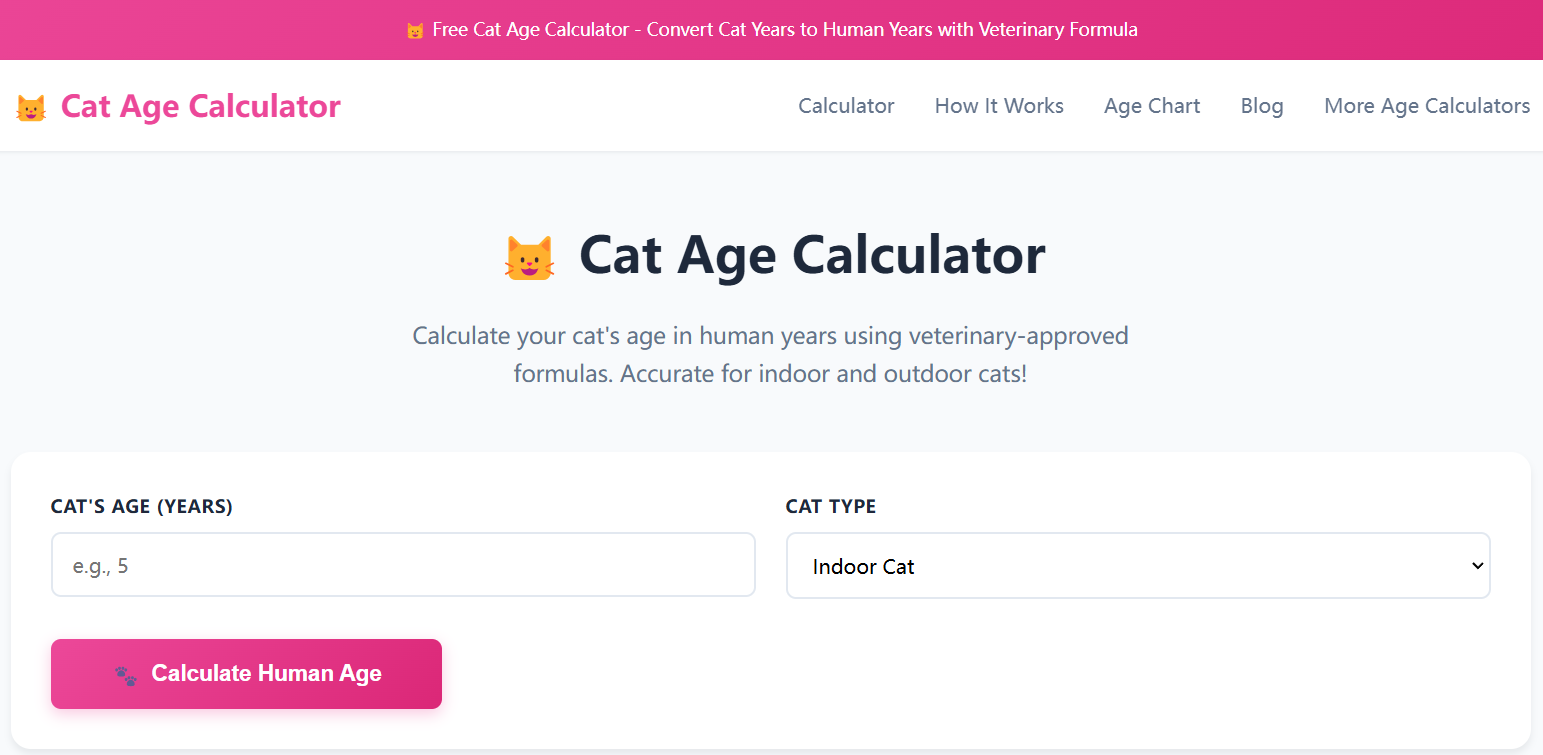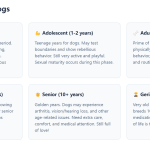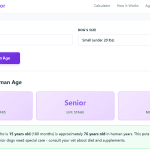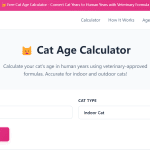Understanding your cat’s life stages is essential for providing optimal care throughout their lifetime. Cats progress through distinct developmental phases, each with unique physical, behavioral, and nutritional needs. This comprehensive guide explores every stage of your cat’s life, helping you recognize milestones and adjust care accordingly.
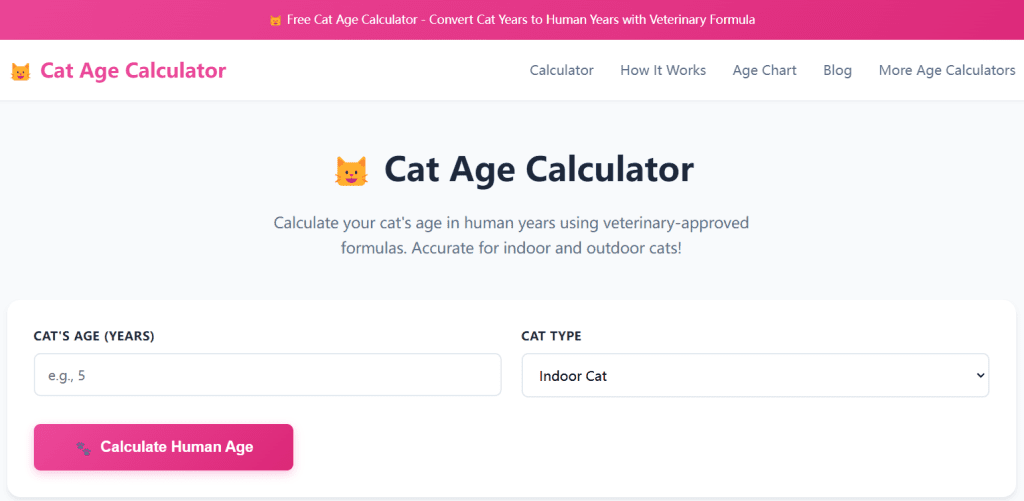
Cat Age Calculator
The Six Life Stages of Cats
Veterinary professionals and feline experts divide a cat’s life into six distinct stages. These classifications help cat owners understand their pet’s changing needs and anticipate age-related developments.
Stage 1: Kitten (0-6 Months)
The kitten stage is a period of rapid growth and intense learning. During these formative months, kittens develop the physical abilities and social skills that will shape their adult personalities.
Physical Development
Kittens are born blind, deaf, and completely dependent on their mother. Their eyes open around 7-10 days, and by three weeks, they begin exploring their environment. The socialization window, critical for developing well-adjusted adult cats, occurs between 2-7 weeks of age. During this time, positive interactions with humans, other cats, and various stimuli are crucial.
By eight weeks, kittens should be fully weaned and eating solid food. Their baby teeth begin emerging at 2-4 weeks, and they develop their adult teeth between 3-6 months. Motor skills develop rapidly during this stage, with kittens becoming increasingly coordinated, playful, and curious.
Care Requirements
Kittens require high-calorie, protein-rich food formulated specifically for growth. They should eat 3-4 small meals daily to support their rapid development. Vaccination schedules typically begin at 6-8 weeks, with boosters administered every 3-4 weeks until 16 weeks of age.
Socialization is paramount during this stage. Gentle handling, exposure to various household sounds, and positive interactions lay the foundation for a confident adult cat. Litter box training usually occurs naturally around 4 weeks when kittens begin imitating their mother.
Play is not merely entertainment but essential learning. Through play, kittens develop hunting skills, learn bite inhibition, and establish social boundaries with littermates.
Stage 2: Junior (7 Months – 2 Years)
The junior stage represents adolescence and young adulthood. Cats reach sexual maturity during this period, typically between 6-12 months, though physical and behavioral maturity continues developing.
Physical Development
Most cats reach their full adult size by 12 months, though some larger breeds like Maine Coons may continue growing until 3-4 years. Energy levels remain high during this stage, and cats exhibit peak athleticism and agility.
Behavioral changes often emerge as hormones influence personality. Unspayed females may experience heat cycles, while unneutered males may begin marking territory and displaying aggressive tendencies. This stage often sees increased independence as cats establish their territorial boundaries and social hierarchies.
Care Requirements
Spaying or neutering is typically recommended between 4-6 months to prevent unwanted behaviors and health issues. After sterilization, cats require fewer calories to maintain healthy body weight, making diet adjustment necessary to prevent obesity.
Junior cats benefit from interactive play sessions that provide physical exercise and mental stimulation. Establishing consistent routines for feeding, play, and grooming helps create stability and strengthens the human-cat bond.
Regular veterinary check-ups ensure your cat’s development stays on track. Annual examinations, dental assessments, and parasite prevention protocols should be maintained consistently.
Stage 3: Prime (3-6 Years)
Prime represents the peak of feline health and vitality. Cats in this stage are fully mature physically and behaviorally, exhibiting stable personalities and optimal physical condition.
Physical Development
During the prime years, cats are at their healthiest and most active. They maintain excellent muscle tone, healthy coat condition, and sharp sensory abilities. Behavioral patterns stabilize, and cats display consistent personality traits and routines.
This stage often represents the easiest period of cat ownership, as cats are independent, healthy, and have established predictable habits. However, it’s also when health vigilance is crucial, as early detection of issues provides the best treatment outcomes.
Care Requirements
Maintaining ideal body weight is critical during prime years. Obesity prevention through portion control and regular exercise establishes healthy patterns that prevent age-related complications. Adult cat food formulated for maintenance rather than growth provides appropriate nutrition.
Annual veterinary examinations should include dental evaluations, as periodontal disease can begin developing during these years. Preventive care, including vaccinations and parasite control, remains essential.
Environmental enrichment prevents boredom and maintains mental sharpness. Puzzle feeders, climbing structures, and regular interactive play sessions keep prime cats engaged and healthy. Monitoring for subtle behavioral or physical changes allows early detection of developing health issues.
Stage 4: Mature (7-10 Years)
The mature stage marks early middle age for cats. While still generally healthy and active, subtle age-related changes begin emerging that require attention.
Physical Development
Cats may show decreased activity levels and spend more time resting. Metabolism begins slowing, increasing the risk of weight gain if diet and exercise aren’t adjusted. Some cats develop early signs of arthritis, though symptoms may be subtle, such as reduced jumping or stiffness after resting.
Sensory changes can begin during this stage, with slight declines in hearing, vision, or sense of smell. Cats may become more set in their routines and less adaptable to change.
Care Requirements
Veterinary examinations should increase to twice annually, allowing earlier detection of age-related conditions. Blood work and urinalysis help identify developing issues before clinical symptoms appear. Common concerns include kidney disease, hyperthyroidism, diabetes, and dental disease.
Diet may require adjustment to senior formulations with modified protein, phosphorus, and calorie content. Weight monitoring becomes increasingly important, as both obesity and unexplained weight loss can signal health problems.
Environmental modifications may be necessary for cats showing early mobility issues. Providing easily accessible litter boxes, food, and water stations reduces physical strain. Lower-sided litter boxes accommodate cats with developing arthritis.
Maintaining mental stimulation remains important. Gentle play sessions adapted to reduced energy levels keep mature cats engaged without overtaxing their abilities.
Stage 5: Senior (11-14 Years)
Senior cats experience more pronounced age-related changes that significantly impact their care requirements. This stage requires increased vigilance and often involves managing chronic health conditions.
Physical Development
Physical signs of aging become more apparent during the senior years. Muscle mass may decrease, and body condition changes are common. Many senior cats develop arthritis, affecting mobility and comfort. Dental disease, if not previously addressed, often causes significant problems.
Cognitive changes may emerge, with some cats showing signs of confusion, altered sleep patterns, or changed social interactions. Sensory decline in vision and hearing becomes more noticeable, potentially affecting confidence and behavior.
Common health issues include chronic kidney disease, hyperthyroidism, diabetes, heart disease, and cancer. These conditions often require ongoing management and medication.
Care Requirements
Senior cats benefit from three to four veterinary examinations annually, with regular blood work monitoring organ function. Many age-related conditions are manageable with early intervention, making frequent monitoring crucial.
Dietary needs often become more complex. Some senior cats require high-calorie diets to maintain weight, while others need calorie restriction. Specialized diets may be necessary for managing kidney disease, diabetes, or other conditions. Ensuring adequate hydration becomes increasingly important.
Environmental accommodations enhance quality of life. Heated beds provide comfort for arthritic joints. Ramps or steps assist cats who struggle with jumping. Multiple easily accessible litter boxes accommodate reduced mobility and potential urgency issues.
Pain management for arthritis and other conditions significantly improves daily comfort. Many cats benefit from anti-inflammatory medications, supplements, or alternative therapies.
Mental stimulation adapted to senior abilities keeps cats engaged. Gentle interactive play, comfortable observation spots, and maintaining familiar routines provide security and enrichment.
Stage 6: Geriatric (15+ Years)
Geriatric cats have exceeded average life expectancy and require specialized care tailored to their individual needs. With appropriate management, many cats thrive well into their late teens or early twenties.
Physical Development
Geriatric cats show significant age-related changes. Weight loss and muscle wasting are common, even in cats eating well. Mobility may be significantly compromised by arthritis and decreased muscle strength. Many geriatric cats sleep 20 or more hours daily.
Cognitive dysfunction syndrome, similar to dementia in humans, affects many geriatric cats. Symptoms include disorientation, altered social interactions, changed sleep-wake cycles, house soiling, and increased vocalization.
Sensory loss may be profound, with many geriatric cats experiencing significant vision or hearing impairment. Chronic health conditions typically require ongoing management and frequent medication adjustments.
Care Requirements
Geriatric cats benefit from individualized care plans developed with veterinary guidance. Frequent examinations, sometimes monthly, allow close monitoring of chronic conditions and rapid response to changes.
Nutritional management becomes highly individualized. Many geriatric cats require highly palatable, easily digestible foods. Warming food enhances aroma and palatability for cats with decreased sense of smell. Multiple feeding stations ensure easy access. Some cats benefit from elevated feeding platforms that reduce neck strain.
Pain management and comfort are paramount. Regular assessment and adjustment of pain medications ensure optimal quality of life. Many geriatric cats benefit from complementary therapies, including acupuncture or physical therapy.
Environmental modifications maximize comfort and accessibility. Non-slip surfaces prevent falls. Very low-entry litter boxes accommodate severe mobility limitations. Extra warmth, soft bedding, and quiet resting areas provide sanctuary.
Close monitoring for changes in eating, drinking, elimination, or behavior allows rapid intervention. Quality of life assessments help guide care decisions, ensuring cats maintain dignity and comfort in their final years.
Recognizing When Your Cat Is Transitioning Between Stages
Understanding when your cat moves from one life stage to another helps you adjust care appropriately. While age provides general guidance, individual cats transition at different rates based on genetics, lifestyle, and health status.
Watch for these signs indicating life stage transitions:
From Kitten to Junior: Sexual maturity signs, decreased growth rate, permanent adult teeth fully emerged, decreased dependency behaviors
From Junior to Prime: Behavioral stabilization, established routines, full physical maturity, decreased play drive
From Prime to Mature: Subtle activity level changes, slight weight fluctuations, first signs of stiffness or mobility changes, increased sleep
From Mature to Senior: More obvious mobility issues, noticeable sensory changes, development of chronic health conditions, significant behavioral changes
From Senior to Geriatric: Marked physical decline, significant weight loss, profound mobility limitations, cognitive dysfunction signs, decreased self-grooming
The Importance of Life Stage Awareness
Understanding your cat’s life stage empowers you to provide proactive, appropriate care. Each stage brings predictable changes and challenges that, when anticipated, can be managed effectively.
Regular veterinary care remains essential throughout all life stages. Early detection of age-related conditions dramatically improves outcomes and quality of life. Building a strong relationship with your veterinarian ensures consistent, knowledgeable care tailored to your cat’s individual needs.
By recognizing and responding to your cat’s changing needs throughout their life, you maximize both the length and quality of your time together. Every stage offers unique rewards and challenges, and understanding these helps you provide the best possible care from kittenhood through their senior years.
Your cat depends on you to recognize their changing needs and adapt their care accordingly. With knowledge, attention, and proactive management, you can ensure your feline companion enjoys a healthy, comfortable life through every stage of their journey.
